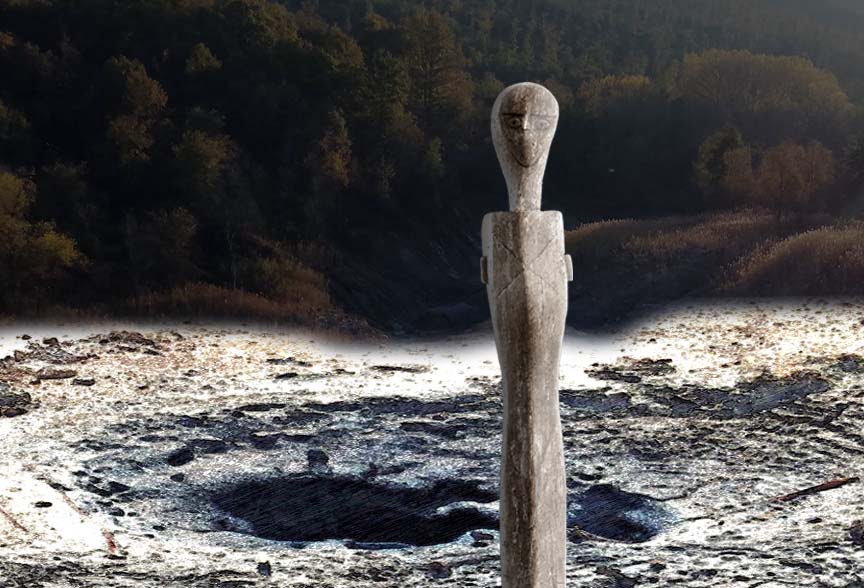di Antonella of Death (Alma) e Alfredo Finotto (Frædior)
Adapted from Sarah Perini (Editor) - Reflections of the Goddess – The Cicada – Oneiros – 2022
There is a place in the middle of Italy, under high mountains,
noble and celebrated for fame in many districts,
the Ansanto Valleys: dark with thick fronds dominates it
on both sides a wooded flank, steep in the middle
thunder among the rocks and suck up the stream.
Here a hideous cave and the glimmers of terrible Dis,
show; immense chasm, in which the Acheron
falls,
opens wide the pestiferous jaws…
Virgil, Aeneid, book VII, lines 563-571
When we decided to found the Kaíla Maatreís, temple dedicated to the Great Mother of Safinim[1], with the aim of re-animating and enhancing the richness of the teachings of our ancestors and our pre-Roman ancestors, with particular attention to the Oscan-Samnite and Etruscan world, especially in the Campania region, we were overwhelmed by a visceral need for connection and revaluation of our places of the heart. In this journey backwards, through time and space, among the numerous layers of meaning and signifier, we have often found ourselves dealing with mytho-stories weighed down by years of distortion or slander, errors, omissions, misunderstandings, oblivion. Hence the desire to serve the Goddess by reviving and restoring visibility to her places and her knowledge, re-defining what our "indigenous Italian shamanism" of yesterday and today has in common.
One of the places that immediately captivated us with its incessant ancestral call is the Valle d'Ansanto, near Rocca San Felice, in the province of Avellino.
These are the inspired words that arose from that initiatory meeting:
From the seething deep of the muddy earth,
among the shining fronds of your sacred wood,
a golden wind rises impetuous,
spiraling with her eternal song:
Meee-fiii-tiiis… and everything falls silent again.
What suffocates now caresses,
dispelling the shadow of danger.
It is she, Mefitis, who hastened to save you,
and to lead you beyond the threshold.
Celebrated since ancient times for its "deadly" fame[2] and the singular geophysical conformation, the Valle d'Ansanto was defined by Servio "umbilicus Italiae"[3] and considered one of the numerous entrances to the Underworld that dot our peninsula[4]. The site holds the Lacus Amsancti (today commonly called "Mefite"), a crater with a perimeter of about 40 meters in which sulphurous waters and carbonate exhalations boil, a place that boasts one of the most important and ancient Sanctuaries of the Goddess: the federal temple of all of the Irpini Samnites, dedicated to the cult of the Goddess Mefitis.
The historical face of Mefitis
Mefitis (or Mephitis, Mephite, Mefite) is an Italic goddess of Oscan-Sabelle origins, whose cult seems to involve a rather vast area, which from the ancient Sannio branches off in a good part of Campania, in Molise, in Ciociaria and in Lucania to then arrive, in the late period, also in Rome and from here to Cremona, Lodi Vecchio (LO) and it would seem also to Bagno di Romagna (FC).
Based on the archaeological finds found, the cult of Mefitis dates back at least to the XNUMXth-XNUMXth century BC, but could be even older. Some scholars propose the XNUMXth century BCE and agree that the cult of her would have persisted at least officially until the XNUMXth century CE
From this period onwards, in the Ansanto Valley, the cult of Mefitis was replaced by that of Santa Felicita.
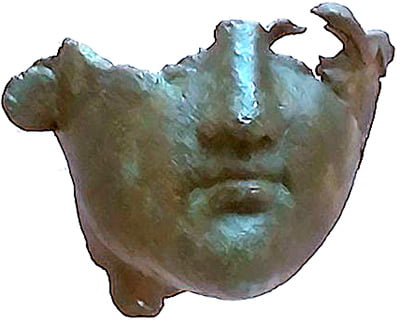
The main centres, currently known, dedicated to the cult of Mefitis would seem to revolve around four sites: Valle d'Ansanto (AV), Valle di Canneto in Settefrati (FR), San Pietro di Cantoni in Sepino (CB) and Rossano of Vaglio (PZ).
The large quantity of votive material, whose oldest finds date back to the seventh century BC (even if, as has been said, the cult of the goddess would be older), consists largely of statuettes of women, seated on thrones or standing , pregnant, or with geese, ducks, doves, cornucopias, paterae[5] and children, but also representations of girls and dancers with flowers or mirrors in their hands. There are also numerous representations of horses, dogs, pigs, cattle, birds, sheep, goats, fawns and wild boars, reproductions of fruit, especially pomegranates, figs, pears, apples and grapes, specimens of eggs and masks, which suggest the practice of sacred drama.
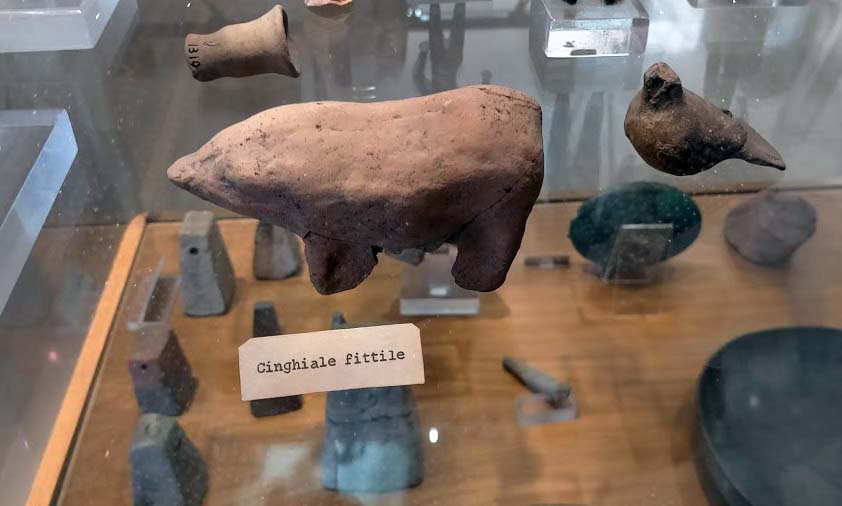
Women's jewels were also found, especially in amber and bronze, agricultural tools and weapons, anatomical votive offerings, loom weights (one of the main activities of Samnite women was weaving), xoana (from the Greek xoanon, carving), male representations of warriors and representations of Mamerte (with bull's horns), Heracles, Jupiter, Janus, Attis and Eros.[6]
The description of Mefitis has come down to us from the numerous literary sources of the late period[7] shows us the image of a dangerous goddess, closely linked to the geophysical phenomena of the Ansanto Valley and identified with the unpleasant smell of the fumes caused by the sulphurous and marshy waters. Even today we commonly use the term "mephitic" to indicate fetid, unbreathable and unhealthy air, or a rotten, depraved and morally corrupt person. The term therefore refers to something evil, harmful, infernal and demonic, it is no coincidence that one of the folk names of the devil is Mephisto or Mefistofele.
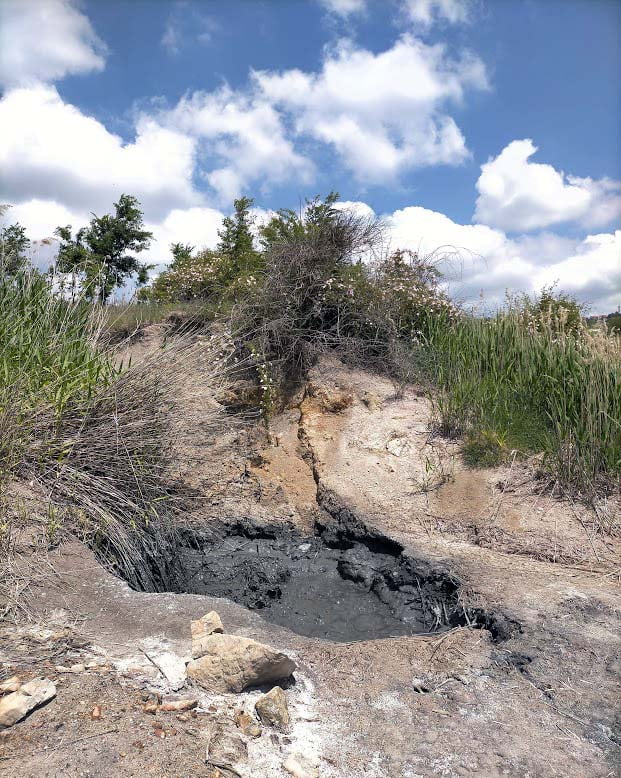
This distorted and partial interpretation of the goddess would appear to be due to the Romanization of originally Italic myths. Despite this, this slow degradation of meaning does not seem to determine a complete detachment from the full and positive meaning of the goddess, which was preserved in popular memory, so much so that Christianization did not make her a demonic entity, but replaced her cult with that of the Madonna, who absorbed the functions of the goddess, highlighting her original role as Mother Goddess. His connection with the Black Madonna of the Canneto Valley, the Madonna del Latte, or dei Lattani, in Roccamonfina, perhaps also with the Madonna del Pomegranate and the Star, and - as mentioned - with Santa Felicita in Rocca San Felice, in the Valle d'Ansanto, and Settefrati (which takes its name from the seven children of Santa Felicita).
Despite having a dark and mysterious face, but not for this evil, Mefitis is a much more complex goddess than one might think. From the temple structures and archaeological finds, including those of the Ansanto Valley, it is evident that she has a link not only with sulphurous, waste or marshy waters, but also with springs, lakes and rainwater[8], as also attested by an inscription found in the Lucan Sanctuary of Rossano di Vaglio: "All the lands and waters belong to Mefite". Also in Capua (CE), on Mount Tifata, once a pleasant place full of springs and streams, a tile fragment indicating the name of the Goddess suggests that Mefitis was associated with the cult of beneficial waters and by extension of Artemis/Diana .
Mefitis is connected to the feminine sphere, to the fertility of the fields, of the flocks and of the women and to the moments of passage and transition of life. But there's more: those who open themselves to the presence of the goddess, especially in places sacred to her, also intuit a protective aspect, propitiatory of unions, curative, magical and oracular.
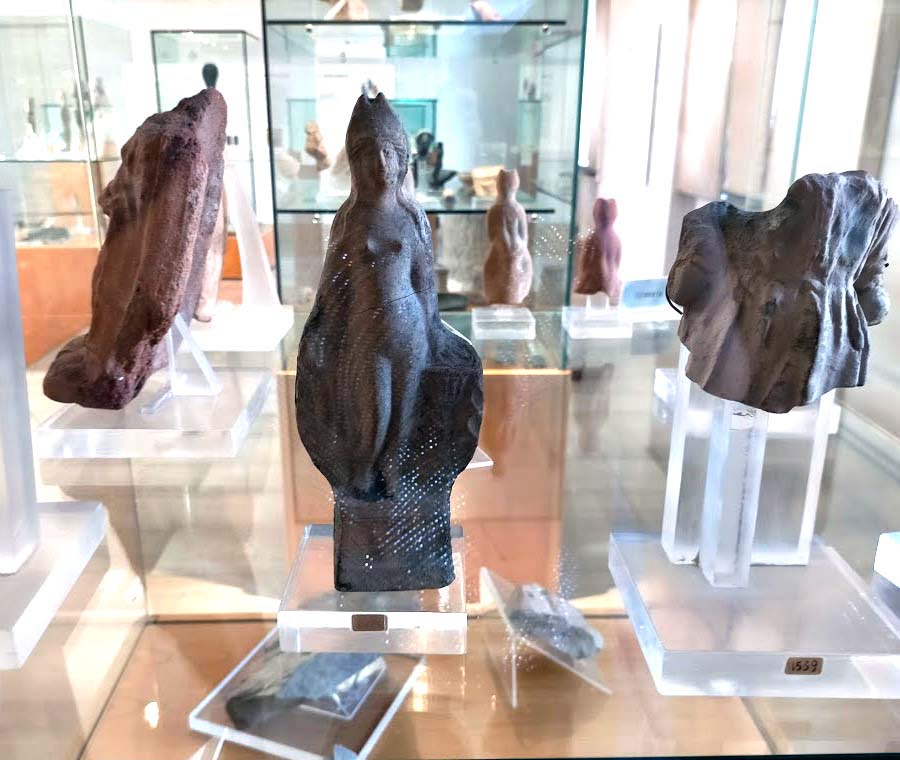
The historical identification of Mefitis is intertwined with the profiles of the goddesses who ended up living with her in the sacred areas, or completely replacing her in the succession of centuries and peoples. Mefitis seems to embody the characteristics of Juno, Venus, Diana / Hecate and Ceres / Libera / Proserpina, as demonstrated by her names, epiclesis and numerous archaeological finds. Equally interesting are her references that seem to put her in contact with Mater Matuta, Vacuna, Albunea and Marìca. Her bond with Capua is confirmed once again by her probable identification with Keri Arentikai[9] at the Sanctuary of Fondo Patturelli or with the tutelary goddess (probably Artemis/Hecate of Cuman ancestry) of the same Sanctuary[10]. Finally, it cannot be excluded that in the late period her cult in Campania may have intersected with that of Isis in Benevento, as happened for Marìca, whose Sanctuary at the mouth of the Garigliano underwent various modifications until it became a Temple to Isis and Serapis in the imperial age. The attempts to associate Mefitis with the Egyptian goddesses Nefti and Mafdet are fascinating, albeit of dubious or difficult attestation.
Beyond the threshold
Let us now lift the veil of oblivion and try to see the multifaceted figure of Mefitis, starting with his name.
The theonym Mefitis, used both as an epithet and as a toponym, is of Oscan origin and would derive from the Indo-European dictions *medhio-dhuihtis[11] or *met-dhui-tis[12], therefore "what smokes/exhales in the middle or together", perhaps in reference to the centrality of the fumaroles, or in any case to the sulfur fumes and the smoke that rises from the volcanic waters.
According to other scholars, however, the origin should be traced back to the Indo-European *medh(u)- and to the verb medhu-io, connected to the sense of "intoxication", therefore "that which intoxicates"[13]. The same root medh– is present in the Indo-European word that indicates mead, and in the Celtic, Germanic and Sanskrit always with the meaning of "stun", "intoxicate". This finds comparison in Latin madeo “to be imbued to satiety”. By definition, what gives a sense of inebriation is intoxicating, which overwhelms the senses and exalts the spirit, therefore it is a matter of sensual ecstasy. The chthonic fumes that cause visions in the Oracle Priestesses of the past are inebriating, the sexual scents, the scent of flowers, resins and spices, which upset and excite the senses, provoking desire and allowing one to free oneself from the mental reins of control, pushing one to recover the dimension of the wild, of freedom, of instinct.
The comparison with the Umbrian mefa of the Iguvine tables, which indicates the sacred focaccia, kneaded with honey, is also compelling. Mefitis would therefore be "the one who stuns and intoxicates" and would have a link with the sweet, nourishing, sensual and golden honey, which could also make her a Queen of Bees.
Other interesting etymological hypotheses are that of Prisciano, who hypothesized mephitis as a transliteration of Greek µεσίτης, mediator, and that of other scholars who lead back mephitis to the osco mefiaicorresponding to the Latin medium and in Greek µéσος, giving the theonym Mefitis the evocative meaning of "She who is in the middle", between the worlds.
Despite the various etymological hypotheses, it is clear that Mefitis covered the role of a liminal goddess, which is well suited to her aquatic and terrestrial nature and to the characteristics of her places of worship.
Everything that flows belongs to her: water, winds, flames, vapours, magma, emotions, blood and life itself, the cycle of existence. She is a Lady of the Threshold, who presides over the passages of life and accompanies souls together with her Wolf. She is the door and the key, the bridge and the border, the Initiator into the Mysteries. As the goddess of Transition, she is also Lady of Transaction, Communication and Commerce, and given the location of her places of worship near sheep tracks and mule tracks, she can also be considered Lady of Transhumance, of a good journey, protector of routes , protective guide in the exploration and movement of humans and animals.
Mefitis is called Utiana, the Sgorgante (appellation that would derive from the Umbrian utur of the Eugubine Tables, similar to Greek ύδωρ “water”), is the water of the Spring that rises from the subsoil to gush out into the open air, filling the earth with Its flow and blessings. She is the Duck Goddess, descendant of the Neolithic Bird Goddess, the source and dispenser of life-giving moisture and, as Mother of Waters, she is also called Mistress of the Source.
Fish, duck and eel are His messengers.
She is Lady of Volcanic and Thermal Waters, she is the fire of the earth which flows in the underground veins of our planet and the fire of fever which brings about the healing crisis, favoring the body's defense against infections, one of the most powerful means by which the body gets rid of accumulated toxins, restoring health and balance.
Mefitis is also the fire in the healing water, she is the Lady of the Malvizza, whose mud is appreciated for the care of the skin and joints, and of the Ansanto Valley, of the fumaroles, of the geysers. In Irpinia, the mud of Mefitis was used to cure the cloven hooves of sheep and goats and to spray the vines, because it was believed to have a useful function against downy mildew. This aspect of Mefitis allows us to imagine a parallelism with the goddess Sulis of Bath (England), with whom she shares not only the bond with the thermal and sulphurous waters that can heal, but also the role of guardian of the passage from the surface to the underground. As with the Valle d'Ansanto, the hot springs of Bath were also believed to be an access to the Underworld, a resting place for the Sun after sunset, an expression of inner light. Both also seem to possess a dark face linked to the curse, in fact they were invoked to punish or avenge a wrong suffered, inscribing the request on clay and lead tablets which were then thrown into the water. In this sense they could also be interpreted as bearers of justice.
She is also the Oscan Venus, Lady of Desire, Mefula, perfumed and intoxicating, the fiery Lover, Mefitis Fisica, she who manifests herself, the vital and transformative energy of the snake that rises from the dark depths revealing herself to the world, she is the propulsive, creative and generative force of Nature. She is the Serpent Goddess of healing and regeneration.
One of her names is Caporinna/Caporoinna and she is therefore also the Goat Goddess, Lady of Caprifico, expression of the cycle of birth-life-death-rebirth. She is the innocent little goat, symbol of new beginnings, the divine Midwife who brings to light and is the protector of life, she is Nether with goat horns, the Queen of Fairies, she who knows and reveals fate, she who whispers in the ear of the oracle and dance in the moonlight. She is the lustful, joyful, sensual, instinctual and wild Diumpa (Nymph in the Oscan language), who awakens the senses and drives to mating and reproduction, she is the fertile Mother with a pregnant belly and breasts full of milk, source of abundance and nourishment.
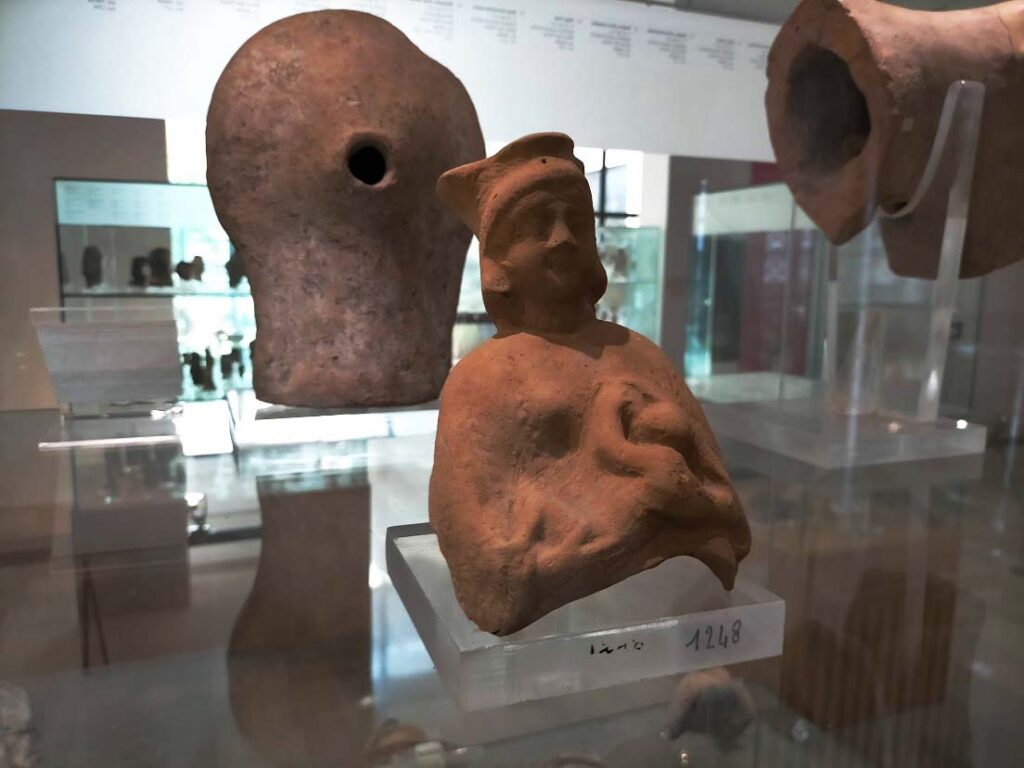
Mefitis is a “ceria” goddess[14], chthonic, called Aravina, Lady of the cultivated land, and Queen, giver of Sovereignty, Lady of the harvest, of healing, magical and edible herbs and plants. Her emblems are the boar, the sow and the doe. As a chthonic Goddess, she is not only linked to water, an element that fertilizes the soil and makes life sprout, but also to the Underworld, since the earth is not only the cradle of life, but also the tomb, the abode of the dead, to which one accessed right across the water, which is a bridge between worlds. She is the Lady of death and regeneration, the guide of souls.
Her sphere of influence also extends to the celestial vault, earning her the title of Domina Giovia. Hers are the uranic waters, the light of the moon that regulates the vital cycles and the flows of existence, the wind that blows away the dangerous miasmas, but also the vapor and the fog that rises from the earth. She is also Mater Matuta, the Mother of Dawn and of the morning dew and Albunea, the Virgin Sibyl, the candid dove, Lady of prophecy and of the galactophorous and healing waters.
It would be simplistic to suggest that an analysis, however thorough, of the sources available to us (literary, archaeological and etymological) can honor the beauty and complexity of Mefitis. We therefore invite you to open yourselves to the gift of subtle feeling and to let yourselves be guided by his call beyond the threshold.
Mefitis in the Maatreic Tradition
According to the tradition of Kaíla Maatreís, Mefitis is one of the most articulated and complete myth-historical manifestations of Maatreís, the Great Mother of the Safinim.
In Her cyclical unfolding through the phases of the wheel of the year (the sacred Húrz maatreic), Mefitis allows us to know her multiple seasonal, archetypal and elemental energies.
For the Samnite populations, lo Hurz it was the sacred garden, a circular enclosure consecrated to worship[15]. Nowadays, travel the Hurz of Mefitis means to experience the faces of the Goddess as Mistress of the Elements, Maiden, Lover, Mother, Ruler and Crone.
"Mephite you are of focus and air"[16] sing the Emians, describing it as homeland with the breath of fire, at the same time the breath of life and death. Her breath purifies, burning away the dross and healing. At the same time, those who approach awkwardly, unprepared, on her threshold risk dying of asphyxiation. She revives, suffocates, stuns, prophesies. The fire of Mefitis is "aria prena", impregnated air, full of its own disruptive essence, of change.
His is the fresh spring water: white, with galactophore properties, and red, with low minerals. Mefitis presides over the fertile waters that quench, heal and bless, but it is also a swamp that boils to the rhythm of the beats of His sighs of fire.
She is Lady of milk and protector of women, children and childbirth. She is the protector of couples and of love, guarantor of bonds of love.
Matron of dark and fruitful wombs, Mefitis is chthonic and infernal, linked to fertility, therefore propitiatory of pregnancies. She is the fertile land that she guards, the cradle that nourishes life, she is the protector of paths, transhumance, fields, animals and shepherds. She is also Lady of the herbs and of the sacred wood.
It is the Cosmic Tree that stands in between, connecting the worlds. His sacred creatures guide us to cross the veil between worlds. She is Lady of the Threshold, Mediatrix and Guide.
Its colors are the yellow of the sulphur, of the wheat and of the ancient broom, the lunar gray of the mud, the coppery bronze of its mineral and ferruginous waters, the white of the milk and the black of the dark earth, the bright green of the fields, that dark of the woods and teal.
This is his song:
I am the fire that moves in the water,
the breath of the dragon that transmutes and refines the Soul,
which transforms fluid water into fine vapor and mist.
I am the fresh spring that regenerates, quenches, nourishes and heals.
I am the rain that makes the fields fertile and calms the impetus of the sun.
I am the water in the earth, the shore, the fertile humus, the healing mud, but also the dangerous and treacherous swamp,
I am the keeper of the threshold, the one who presides over every step, the guide of souls, the light in the dark, the compassion that hides in every natural end and the sweetness of every beginning.
Mine is the power of life and death.
I am the dawn and the dusk.
I am the womb and the grave.
I am the Moon which marks the time, which protects the mysteries of the night and the secrets of the unconscious.
I am the giver of abundance and magic.
I am the one who protects and supports mothers, the arms that cradle and the breasts that nourish the new born.
I am the Queen of Witches, the Mother of Healers, the inspiration and voice of the Oracle.
I make all living creatures fertile, I bring the power of generation as a gift.
I cut and I weave, I create and I destroy, I bind and I loose.
I am the sulfur and the gold.
I am male, I am female.
I look in all directions.
I protect against diseases, but I can also restore balance and awareness through them.
I am the Justice that has no master,
Liberty that does not accept constraint,
the wisdom of silence.
I am the one who gives, nourishes, cares and welcomes.
I am the Dark Virgin and the White Maiden.
I am the sensual Nymph and the wild Lover,
I am the loving, just and compassionate Mother, but also the Terrible Mother.
I am the Bride, I am the Fairy and I am the Witch.
I am the breath of the wind, the sigh that comes from the depths of the earth, the voice of the cave that speaks to those who know how to listen.
I am the rock and the mighty mountain.
I am Mefitis!
[1] In our tradition, Safinim is the historical and mythological land of our Italian ancestors, sacred to the Great Mother Safina (Maatreís) and the Sacred Heifer Vitula/Vitelia, which we associate with the primordial name of our peninsula (Viteliú).[1]
[2] Marcus Tullius Cicero, De Divination, I, 36, 79.
[3] Maurus Servius Honoratus, Grammatical Servii in Vergilii Aeneidos, VII, 563.
[4] Publius Vergilius Maro, Aeneid, VII, 563-570.
[5] The patera is a bowl-shaped utensil, or shallow cup, used by priests in Roman times to offer libations during ritual sacrifices.
[6] To deepen these aspects, we recommend reading specific texts: "Mefitis, from the Mothers to the Mother" by Flavia Calisti; "The Sanctuary of the Goddess Mefitis in Rossano di Vaglio" by Antonella Andrisi; “Mefitis revisited (twenty years later…and beyond)” by Paolo Poccetti; “Mephitis goddess of health?” by Maria Federica Petraccia.
[7]Virgil, Servius, Cicero, Pliny the Elder, Sidonius Apollinaris, Claudianus, Festus, Varro, Tacitus, Pomponius Porphyryon, Vibius Sequestre, Pseudo-Placido.
[8]Calisti, F. (2012): “Mefitis in Virgil: saevamque exhalat opaque mephitim”, in Roman studies, 60, 10
[9]Caiazza, D. (2005): “Mefitis Regina Pia Iovia Ceria. First notes on the iconography, nature, skills, homologous divinities and cultural continuity of the Domina Italica”, in Italic ars. Studies in honor of Giovanni Colonna for the I Sanniti prize, 129-218.
[10] Prosdocimi, AL (1989): “The religion of the Italians”, in Ancient Mother. Italy omnium terrarum parens, Milan, 538.
[11] Ribezzo, F. (1926): "For the etymology of Mefitis", RIGI, X, 94.
[12] Pisani, V. (1964): The languages of ancient Italy beyond Latin, Turin, 96.
[13]B. Lavagnini (1923): “For the etymology of Mefitis”, pp. 344 – 350 MR Torelli (1990): “The cults of Rossano di Vaglio”, [in] MR Salvatore (cur.), Basilicata. Roman expansionism in southeast Italy. The archaeological picture, Proceedings of the conference (Venosa, 23-25 April 1987), Rome, 83-93.
[14]The term «ceria» indicates the cereal, terrestrial and chthonic function of the goddess. Caiazza, D. (2005): “Mefitis Regina Pia Iovia Ceria. First notes on the iconography, nature, skills, homologous divinities and cultural continuity of the Domina italica”, in Italica ars. Studies in honor of Giovanni Colonna for the I Sanniti prize, 129-218.
[15]For further ideas and information, we refer to the study of the Osca Table.
[16]Emian (2016): “Mephite”, Khymeia (CD), https://youtu.be/MU6VzpVsxSM.
Antonella of Death (Alma) e Alfredo Finotto (Frædior)
Adapted from Sarah Perini (Editor) - Reflections of the Goddess – The Cicada – Oneiros – 2022
REFERENCES
- Antonella Andrisani – The Sanctuary of the Goddess Mefitis in Rossano di Vaglio. A reinterpretation of the archaeological and cultural aspects – Matera – 2008;
- Domenico Caiazza – “Mefitis Regina Pia Iovia Ceria. First notes on the iconography, nature, skills, homologous divinities and cultural continuity of the Italic Domina" - in Italic ars. Studies in honor of Giovanni Colonna for the I Sanniti prize – 2005 – pp.129-218;
- Flavia Calisti – Mefitis: from the Mothers to the Mother – Rome – 2006;
- Flavia Calisti - "Mefitis in Virgil: saevamque exhalat opaque mephitim" - in Roman studies – 2012 – p. 60;
- Luca Cerchiai - "Notes on the cults of Marìca and Mefite" - in OCNUS 7 - 1999 - p. 235-41;
- Marisa de' Spagnolis – The Goddess of the Sources of Foce Sarno – Mefitis and the Lucus Iunonis – Rome – 2014;
- Emian – “Mephite"- Khymeia – CD – 2016;
- Raffaele Loffa – “The Goddess Mefite and the Ansanto Valley” – in Carife.eu (website);
- Gennaro Luongo - "Santa Felicita and the goddess Mefite: which relationship?" – in Monks, Jews, saints – 2008 – p. 167-193;
- Rossella Patricia Migliore – “On the trail of an ancient cult. Recent studies on the small votive plastic found in the Patturelli Fund" - in Curti between history and archaeology – 2011 – p. 23-32;
- Maria Federica Petraccia – “Mefitis goddess of health?” – in Geryon – vol. 32 - 2014 - pp.181-198;
- Vittore Pisani – The languages of ancient Italy beyond Latin – Turin – 1964;
- Paolo Poccetti - "Mefitis revisited (twenty years later ... and beyond with minimal prolegomena and epilegomena)" - in The cult of the goddess Mefite and the Ansanto Valley, Research on an archaeological site of the Hirpini Samnites – Avellino – 2008;
- Aldo Luigi Prosdocimi - "The religion of the Italians" - in Ancient Mother. Italy omnium terrarum parens – Milan – 1989;
- Ivan Rainini – The Sanctuary of Mefite in the Ansanto Valley – Rome – 1985;
- Francesco Ribezzo - "For the etymology of Mefitis" - in RIGI – X – 1926.

